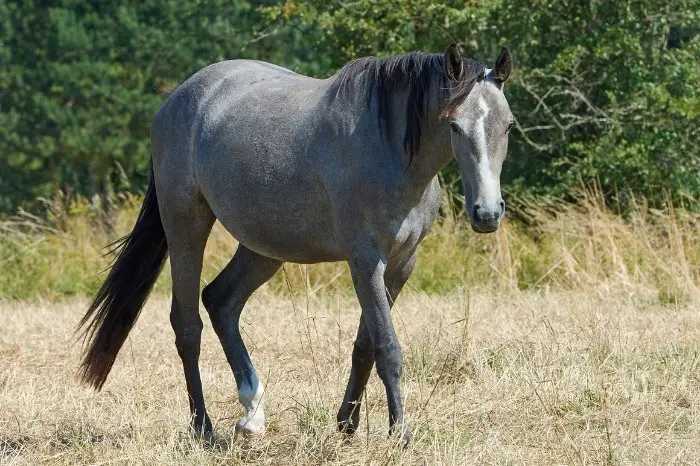Last Updated on January 26, 2022
The grey horse color includes a wide range of different types of grey horses. These range from a completely white coat color through to a dark, steely grey. But why do some horses turn a grey color?
Why Do Some Horses Turn Grey?
The coat color of horses occurs because of their genetic makeup. Each horse inherits genes from its parents; these genes are paired, and the horse gets one of each pair from each parent. It is the combination of genes within these pairs that determines the color and markings of the horse.
The basic color of a horse is a result of whether it inherits two black genes, two red genes, or one of each. This results in a base color of either black, chestnut, or bay. These three common horse colors are then affected by other genes, which creates the myriad of colors and patterns we see in the equine world.

Other color-changing genes include dilution genes, that lighten the overall color of the horse. Some horses also inherit the grey gene from their dam, sire, or both. The grey gene causes gradual depigmentation of the hair, over several years, resulting in a grey horse color.
This is an unusual gene, as it is not always clear when a foal is born if it carries the grey gene or not. This means that a foal might be born a bright bay, or a golden chestnut, or even jet black, but within a few years, it could be completely white!
The gene responsible for hair turning grey is dominant over all other color genes. This means that it will overrule all other genes responsible for coloring, and the horse will inevitably turn grey. This occurs whether the horse has one or two copies of the grey gene.
Check Out Types Of Roan Horses And Colors Explained
How Do Horses Turn Grey?
Horses turn grey in stages, and there is no set time frame in which this occurs. It is normal for a grey horse to exhibit predominantly grey coloring by the time it is an adult. However, the coat will continue to lighten over time, and by the time a grey horse reaches its geriatric years, it will be almost white.
Omega Horseshine The Omega 3 Supplement, Helps Maintain a Shiny Healthy Coat
Here is a summary of the stages of the greying process in horses:
-
Foal
The foal will not normally have any grey hairs at birth, but a foal of any color can turn grey. This can lead to confusion in the horse’s passport, where its color at birth is normally recorded. When the foal sheds its birth coat during the first year of life, it may develop some grey hairs.
-
Intermediate Stage
As the horse moves through adolescence, the coat will become lighter. This is because white hairs are becoming more prevalent, and intermingling with colored hairs. For example, a black horse will have an even number of black and white hairs, resulting in a steel or iron grey color.
At this stage, the horse might also develop a spotted appearance, called dappled grey.
This intermediate stage is often confused with other colorings, such as roan. However, a grey horse will continue to become lighter, whereas a roan will stay the same color. Roan horses also have darker-colored legs, whereas a grey horse will normally develop lighter legs.
-
Late Stage
A grey horse does not normally become lighter evenly across the whole body. The flanks and the legs normally retain some color during this stage, whilst the other areas become lighter.
-
Complete Depigmentation
This is the final stage of greying, where the horse is almost completely white. Many horses stay this color, whilst others develop small pigmented freckles, called flea-bitten grey. The skin of a grey horse remains black, even when the coat is pure white.
Summary
So, as we have learned, the gene that causes a grey horse color is very dominant and will overrule all other color genes. However, most horses are not born grey and will turn grey gradually over a number of years. This is because the grey color gene causes the hairs of the coat to gradually lose pigmentation.
We’d love to hear your thoughts on the grey horse color! Maybe a steely dapple grey is one of your favorite horse colors? Or perhaps you’re not sure if your new foal is going to be grey or not? Leave a comment below and we’ll get back to you!
FAQ’s

Kate Chalmers is a qualified veterinary nurse who has specialized in horse care for the vast majority of her career. She has been around horses since she was a child, starting out riding ponies and helping out at the local stables before going on to college to study Horse Care & Management. She has backed and trained many horses during her lifetime and competed in various equestrian sports at different levels.
After Kate qualified as a veterinary nurse, she provided nursing care to the patients of a large equine veterinary hospital for many years. She then went on to teach horse care and veterinary nursing at one of the top colleges in the country. This has led to an in-depth knowledge of the care needs of horses and their various medical ailments, as well as a life-long passion for educating horse owners on how to provide the best possible care for their four-legged friends.
Kate Chalmers BSc (Hons) CVN, Dip AVN (Equine) Dip HE CVN EVN VN A1 PGCE

